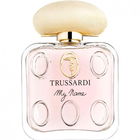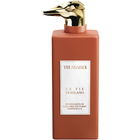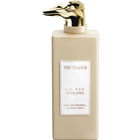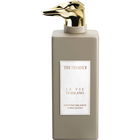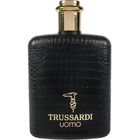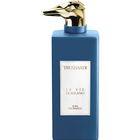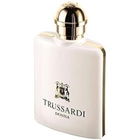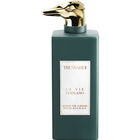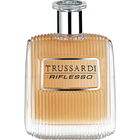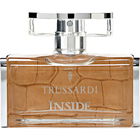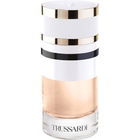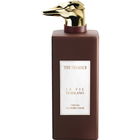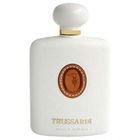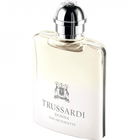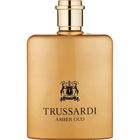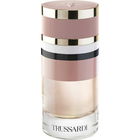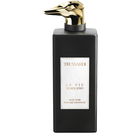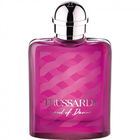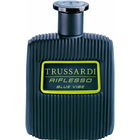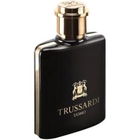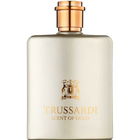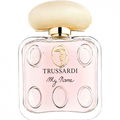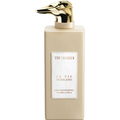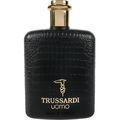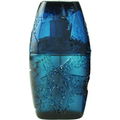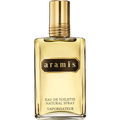12/06/2021

Intersport
113 Reviews
Translated · Show original

Intersport
Very helpful Review
9
L'Azione!
My first encounter with Action Uomo was in '90 or '91 somewhere between Umbria and Verona. Releases back then were less synchronized and often stayed in their country of origin - like here in Italy - for half a year or more. My fixation during this first contact was certainly also due to tactile perceptions; Action Uomo's all-plastic bottle clearly stood out in form, color, and typography from everything packaged in glass bottles. The finely textured surface, perhaps a nod to the black leather imitation already used in Trussardi Uomo (1983), but also - in its petrol-green color - a link to the objects, structures, and color palettes that, albeit belatedly, could just as well have come from Memphis Milano or Post Design - Trussardi's headquarters next to the Scala was not far from Milan in the '80s. I quickly enjoyed this initial 50ml and was ultimately reminded of Action Uomo years later - in 2009.
Action Uomo is also something I would have loved to see in a book like 'Great Italian Perfumery'. The fragrance represents the brief, highly exciting, experimental but also under-documented period of Italian perfumery in the late '80s / early '90s, when several houses released their 'second men's perfume', which often suggested a maximum difference from their respective debut works, such as Versace with L'Homme (1984) and Versus Uomo (1991) or Krizia's Spazio Uomo (1993). And then there's Action Uomo: the Italian herbiness of the '80s, a kind of terminal moraine remnant and leftover from the Renaissance - and monastery garden aromatics are present. Efforts to connect with trends like Cool Water (1988), Jazz (1988), or early proto-aquatics are noticeable; however, Action Uomo clearly distinguishes itself with a charmingly unnatural and powerful mint-artemisia combination. School's review here addresses the idiosyncrasy of Action Uomo excellently. Even though mint-fougère doesn't sound particularly unusual, Action Uomo was, and with its technoid facets, similar to Krizia's Spazio Uomo, it was a few years ahead of its time. I don't know (yet) of any releases that targeted and highly dosed mint in the middle of such a multifaceted framework before Action Uomo. Later perfumes like Series 1: Leaves - Mint (2001) or Series 5: Sherbet - Peppermint (2003) were simpler in construction, and I was only led back to Action Uomo's menthol quality through Geranium Pour Monsieur's (2009) mouthwash accord. Aside from these cool notes, Action Uomo's development is Italian-herbal, fougère-like with minimal jazz associations, but without its pronounced geranium, and ends classically with an oakmoss-amber-tonka mélange. With this content, Trussardi may have leaned a bit too far out of the window; three years later, a flanker, Action Sport (1993), was released - this time without mint, but far more conventional, aside from the almost tautological name combination of Action plus Sport. Recently, Diptyque released Eau de Minthé (2019), an '80s fougère homage that generously and somewhat boldly borrowed from Action Uomo, Jazz, and Drakkar Noir, but did so with somewhat clumsy sampling.
Action Uomo is also something I would have loved to see in a book like 'Great Italian Perfumery'. The fragrance represents the brief, highly exciting, experimental but also under-documented period of Italian perfumery in the late '80s / early '90s, when several houses released their 'second men's perfume', which often suggested a maximum difference from their respective debut works, such as Versace with L'Homme (1984) and Versus Uomo (1991) or Krizia's Spazio Uomo (1993). And then there's Action Uomo: the Italian herbiness of the '80s, a kind of terminal moraine remnant and leftover from the Renaissance - and monastery garden aromatics are present. Efforts to connect with trends like Cool Water (1988), Jazz (1988), or early proto-aquatics are noticeable; however, Action Uomo clearly distinguishes itself with a charmingly unnatural and powerful mint-artemisia combination. School's review here addresses the idiosyncrasy of Action Uomo excellently. Even though mint-fougère doesn't sound particularly unusual, Action Uomo was, and with its technoid facets, similar to Krizia's Spazio Uomo, it was a few years ahead of its time. I don't know (yet) of any releases that targeted and highly dosed mint in the middle of such a multifaceted framework before Action Uomo. Later perfumes like Series 1: Leaves - Mint (2001) or Series 5: Sherbet - Peppermint (2003) were simpler in construction, and I was only led back to Action Uomo's menthol quality through Geranium Pour Monsieur's (2009) mouthwash accord. Aside from these cool notes, Action Uomo's development is Italian-herbal, fougère-like with minimal jazz associations, but without its pronounced geranium, and ends classically with an oakmoss-amber-tonka mélange. With this content, Trussardi may have leaned a bit too far out of the window; three years later, a flanker, Action Sport (1993), was released - this time without mint, but far more conventional, aside from the almost tautological name combination of Action plus Sport. Recently, Diptyque released Eau de Minthé (2019), an '80s fougère homage that generously and somewhat boldly borrowed from Action Uomo, Jazz, and Drakkar Noir, but did so with somewhat clumsy sampling.
8 Comments







 Top Notes
Top Notes  Artemisia
Artemisia Bergamot
Bergamot Galbanum
Galbanum Neroli
Neroli Peppermint
Peppermint Heart Notes
Heart Notes  Coriander
Coriander Cyclamen
Cyclamen Lavender
Lavender Rosemary
Rosemary Base Notes
Base Notes  Amber
Amber Cedar
Cedar Moss
Moss Musk
Musk Tonka bean
Tonka bean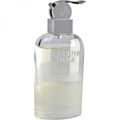






 Charilaos77
Charilaos77 Scorpio
Scorpio Rutil
Rutil